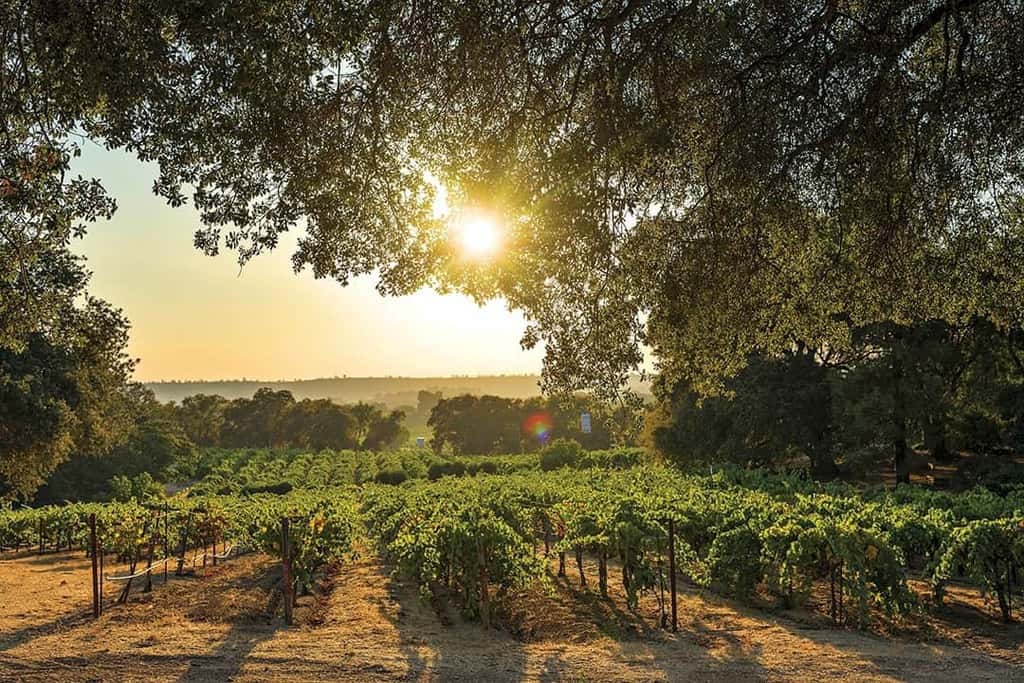A few months back, I was at my local wine bar for a winemaker tasting. I was looking forward to the evening primarily for two reasons: Emily Haines, the winemaker pouring, is a young biochemist turned winemaker and she’s producing wines for Terra d’Oro in Amador County, California. Emily’s career arc was fascinating to me. She double majored in biochemistry and biotechnology at Eastern Washington University and was formerly researching Type 1 diabetes at the local VA hospital before turning her sights on wine. Knowing a few other incredible winemakers from Washington, I knew I needed to learn both about Emily and her wines; plus, I also wanted to learn about this California AVA in the foothills of the Sierra Nevada mountains.
Now admittedly, I knew nothing about Amador County going into the tasting. It wasn’t a wine region on my radar. However, after tasting through these wines and sitting with Emily, who is about as congenial and knowledgeable as they come, it’s now an area high on my list of places to visit. So, let’s discover a few things together:
The History of Amador County
This is perhaps the story that most fascinated me about this region with its rolling hills, oak trees, mountains and pines: it was once the largest wine producing region of California. Known as the Mother Lode, this region drew thousands in the 1850s for the famous gold rush. Towns sprouted up throughout the foothills and as they did, so too did the vineyards. During the gold mining years, Amador County was home to more than 100 wineries. However, as mining came to an end and prohibition came into effect, the wine industry was devastated and remained relatively non-existent until 1970, when Terra d’Oro became the first winery established (under the Montevina label) post-prohibition by Cary Gott and Walter Field.

Amador County American Viticultural Area
Today, Amador County, although not as well-known as it was in the 19th century, is once again a bustling wine region. The area is renowned for its Zinfandel, but also produces numerous other European varietals. With over 3,700 acres of vineyards, and more than 40 wineries, it is the California region with the most organic vineyards (owing largely to dry-farming practices) as well as home to some of the oldest vines. In fact, some of the vines date back to the 19th century, including the Grandpère vineyard which was planted before 1869 and the Deaver vineyard dating to 1881. A warm climate region, the vineyards of Amador County receive significant amounts of sun which aids in the ripening of the grapes, while the diurnal temperature fluctuations allow the grapes to maintain their natural acidity. Additionally, many of the vineyards are planted in volcanic soils and sandy clay loam with most between 1,200 and 2,000 feet above sea level. The AVA includes two sub-appellations, the Shenandoah Valley of California to the north and Fiddletown to the east.
Once nearly exclusively dedicated to Zinfandel (in fact, the Deaver vineyard was the original source for Sutter Home’s popular White Zinfandel grapes), today Amador County produces a wide array of grapes suited for the warmer climate, especially those of Italian and southern French origin. While Zinfandel still accounts for 2,000 acres of the region’s vineyards, you will also find Barbera, Aglianico, Teroldego, Sangiovese, Tempranillo, Graziano, Syrah, Grenache, Mourvèdre and Petit Syrah. Sauvignon Blanc, Pinot Grigio and Marsanne can also be found, but in smaller amounts. Most white grapes are grown in the nearby Clarksburg AVA where the flatter terrain and greater rainfall promote more even ripening for the grapes and the bay breezes provide cooler conditions.
More Than Wine
Amador County is certainly a Winetraveler’s destination with more than 40 wineries, only one of which requires an appointment while the rest offer walk-in tastings in laidback, relaxing tasting rooms. And if the great outdoors, history and quaint western towns are of interest, you’ll find it all here as well. With the Sierras as a backdrop, Amador County makes for a great picnic destination with its giant oak trees, vineyards and mountain forests. It is also home to Black Chasm National Natural Landmark, a cave filled with sparkling helictites, stalactites, flowstones and draperies that offers tours of the rare formations. The historic mining towns are also made for easy strolls, antique shopping, dining and museum tours. The quaint town of Sutter Creek will take you back in time as you stroll and sip wine in the numerous tasting rooms. And when you’re ready for a little activity, you can cycle, ski or hike throughout the region and absorb the breathtaking views.
How to Get To Amador County and Where to Stay
The easiest way to get to Amador County is to fly into Sacramento International Airport, which offers numerous daily flights from across the country. Once in Sacramento, the wine country of Amador County is a short 1-1/2-hour drive east toward the Sierra Nevada range. Numerous bed & breakfasts as well as hotels offer an array of accommodations throughout the region and several car services are available to take to make a day of wine tasting. Rest, a boutique hotel in Plymouth, offers rooms, a car service and a high-end restaurant with an outstanding wine list. (Winetraveler tip: Rest is also close to Terra d’Oro winery which you’ll want to visit!)
Winetravelers can also make it a multi-region wine vacation. El Dorado County wine country is immediately north, Lodi is a short 40-minute drive to the southwest with Calaveras County on the way. And if you’re still not wined-out Napa Valley is only 100 miles west. That said, after tasting through wines of the region, I think I could easily lose myself exploring Amador County for a week and still have more to discover.
Coming soon to Winetraveler: A special Q&A with Terra d’Oro winemaker, Emily Haines and what excites her about this region as well as 10 wineries to visit in Amador County.
